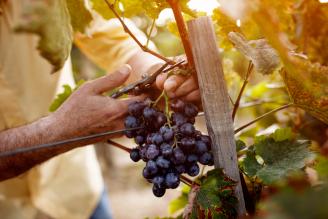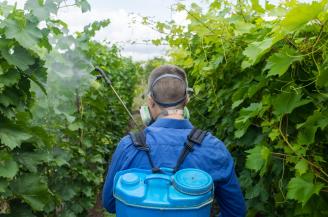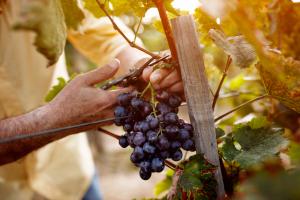Bioprotection de la vendange : où en est-on en 2023 ?

At SITEVI 2021, la bioprotection des vendanges bioprotection of grape harvests was a key topic. Indeed, for several years now, the question of optimizing crop protection has been one of the major concerns raised by winegrowers.
Start-ups, firms and other institutes are constantly on the lookout for innovative technological solutions to current viticultural issues.
With this in mind, the IFT (indices de fréquence de traitements - treatment frequency indexes) have gradually taken on vital importance in the sector. The increase in HVE (High Environmental Value) certification continues, with percentages rising in 2020 (+52% in six months). This figure reflects the determination of winegrowers to become more involved in an agroecological transition.
This figure reflects the determination of winegrowers to become more involved in an agro-ecological transition.
What is bioprotection?
Bioprotection of the harvest is a major challenge for sustainable development. The aim is to limit any adverse effects on the sanitary quality of the wine, and at the same time avoid large-scale food losses.
It is an alternative to the antiseptic role of SO2 (sulfur dioxide) in the pre-fermentation phase. In practice, bioprotection involves inoculating grapes (or must) with known and controlled micro-organisms (yeasts and/or bacteria in low doses) to control the development of indigenous flora. It also provides effective protection against microbial risks at the start of the oenological process and upstream of fermentation.
The main advantages of bioprotection
|
For winegrowers, adopting bioprotection means more respectful cultivation practices for both people and the environment. For consumers, it guarantees the purchase of healthy products, free from sulfites and allergens.
What are the factors involved in wine spoilage?
In oenology, the populations of micro-organisms in the vineyard are made up of different elements: yeasts, aerobic bacteria, molds, fungi, etc. Microflora are present in a variety of ways. Microflora are present in a minority on grapes or in the cellar (Saccharomyces and non-Saccharomyces yeasts, acetic bacteria, spoilage germs and lactic acid bacteria).
Wine spoilage can be caused by a number of different phenomena:
- Changes in environmental conditions when the must enters the cellar: temperature change, alcohol production, SO2, lack of oxygen, acidity and pH levels, etc.
- Toxin killer: protein compound present in many species and having an antimicrobial effect.
- Quorum sensing: production of signal molecules leading to a change in gene expression.
Good practices for implementing bioprotection
|
It is recommended to avoid using Saccharomyces or non-Saccharomyces fermentative yeasts for a bioprotection process on white or rosé wine. In fact, there is a risk that alcoholic fermentation may be triggered prematurely, before settling has been completed. In the case of red wine, it is preferable to avoid yeasting after using Saccharomyces, or non-yeasting after using non-Saccharomyces.
The application of bioprotection in two specific contexts

Claudie Roulland, research engineer and head of the viticultural station's microbiology laboratory, used bioprotection in a Cognac vineyard, in partnership with oenological product companies.
After controlling the implantation of strains in musts after settling, implantation was successful in 90% of the 47 batches tested. However, without the use of SO2, this process is restrictive, particularly in terms of timing, and has certain limitations (cold vintage, rot, colonization of the cellar by LSA, etc.).
a group of winegrowing and trading professionals from the Rhône Valley, has researched the limits of bioprotection in the case of spoilage flora in the must and risky oenological practices. After grape harvesting, crushing and destemming, 10,000 cells of spoilage flora per mL were added, followed the next morning by the addition of bioprotectant. After pre-fermentation maceration, yeast was added. In the end, the wine was declared unmarketable (oxidation, phenols, acetic bacteria, etc.). In this case, bioprotection was not a miracle solution for altered grapes.
State of progress in the field
For several years now, bioprotection has been the subject of a number of projects and field trials in wine-growing regions. These are based on both yeast and bacterial strains. The main objectives are to assess the efficacy of the process, understand its mode of action and optimize its use.
At present, experience feedback highlights the variable effectiveness of the process. Bioprotection is not a complete alternative to SO2. For a more complete response to the risks of must oxidation and aromatic loss, it is advisable to combine this technique with other protective practices. Moreover, bioprotection does not always mean biocontrol, since the strain does not permanently colonize the entire environment.
Bioprotection yeast can interfere with the alcoholic fermentation process, since incompatibility can occur, slowing down AF. During the bioprotection process, it is mainly non-saccharomyces yeasts (Metschnikowia, Torulaspora delbrueckii, Pichia kluyveri, etc.) that are recommended. However, yeasts are not the only bioprotection option in oenology. Adding lactic acid bacteria (Oenococcus oeni) during the alcoholic pre-fermentation phase is also a solution for reducing the risk of microbial spoilage.
Bioprotection limits the development of indigenous flora in musts, if carried out under certain optimal conditions. This alternative to SO2 must be validated after a pre-harvest microbiological pre-diagnosis. However, despite the advantages that the process reflects, it does not systematically protect against oxidation.
